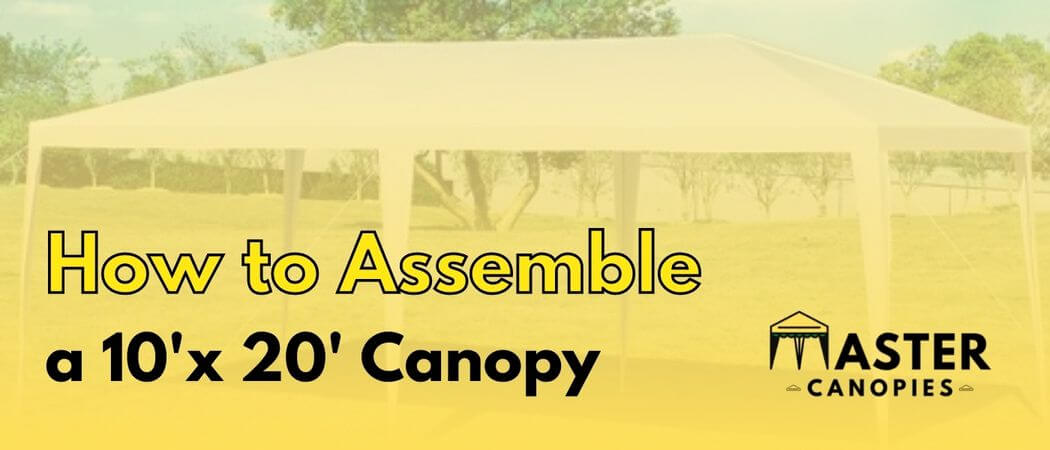
How to Stop Water Pooling on Canopy: Stop Water Buildup
How to Stop Water Pooling on Canopy: Stop Water Buildup Published August 20th, 2022 by Allen Campbell Do you have a canopy that won’t stop
Published August 20th, 2022 by Allen Campbell

From summer camps to music festivals, canopy tents provide a shaded and comfortable oasis in the midst of the sun and crowds. Under the shade of a canopy tent, you can relax, enjoy the scenery and take a break from the heat. But what do you do when your canopy tent starts to sag in the middle?
Sagging tent fabric can be quite painful and frustrating, especially if you’re spending a summer outdoors. However, there are a few methods to solve this issue and get your canopy back in good condition.
I’ll be exploring some tips on how to repair or prevent sagging canopy tents in this blog post – stay cool and read on for more information!

There are a number of factors that can contribute to tent sagging, and by understanding these factors, you can take steps to ensure that your tent stays in good shape for years to come. So, below are some of the things that can cause your canopy tent to sag:
The main reason why a tent canopy might sag is that the fabric used is of poor quality. If the material is thin, it will sag when wet or humid, and if it’s not properly supported, it will also sag.
This can cause the tent to collapse, so it’s important to choose a canopy made of high-quality materials. When choosing a canopy for your next camping trip, make sure to choose one that is made of thicker yet lighter materials to avoid any problems.
The age of a tent can contribute to sagging, as over time, the fabric may become looser and less able to support the weight of the structure. In addition, the poles and other supports may weaken with age, making it more difficult for the tent to hold its shape.
This can lead to an overall sag in the fabric, compromising the structural integrity of the tent and making it less safe to use. If you have an old tent that you’re planning to use, make sure to fix it before setting it up.
The weather has a major responsibility in how well your tent performs. Wind, in particular, can cause a tent to sag by putting pressure on the fabric. Humidity can also cause a tent to sag, as the increased water vapor in the air makes the fabric heavier.
And finally, heat can cause a tent to expand, leading to sagging. All of these factors can make a tent less effective at protecting you from the elements, so it’s important to be aware of them when choosing a camping site.
If you don’t use the tent properly, it can cause the fabric to sag and lead to uncomfortable camping conditions. This can be a real problem, especially if you’re trying to get a good night’s sleep. Make sure that you use enough stakes to support the tent and distribute the weight evenly.
When you put too much weight on one side or corner of your tent, it causes the fabric to sag. This makes it difficult for people inside to stay comfortable, as they will constantly be fighting against the sagging.
It’s necessary to disperse the weight equally around the tent in order to avoid these problems. With a little care, you can avoid these problems and have a great time camping.
It’s time to start fixing that sagging tent! The first thing you need to do is gather all materials which I have listed above. Once you have all materials, let’s get started on those notches.
The first step to fixing a tent sagging is to cut notches from where the foam tube will meet another end of the tube. Generally, it does not take too many cuts to fix the problem.
In this step, you need to take the help of your friend or assistant to hold up the fabric in an upward position from where you will be working. It makes access to foam tubes easy, and you can move further smoothly. Afterward, you need to slightly push the foam tube between the fabric and support beams.
Check if the insulation foam tube is in the right place or not, and also see to it that ends of the noodle are secured between two pieces of fabric and a beam.
Repeat the same process with other foam tubes to fix the problem of sagging in your tent.
You have successfully fixed your sagging tent! Now, you can sit back and enjoy camping under a tight and taut tent.
If you have a sagging canopy, follow the tips I’ve outlined, and you should be able to fix it yourself without too much trouble. From my experience, the main cause of a sagging canopy is usually due to one of three things: age, weather conditions, or incorrect setup.
Remember to take your time and be careful when working with the fabric- if something doesn’t seem right, reread the steps or ask a friend for help before continuing.
To avoid having to fix a sagging tent, be sure and inspect it regularly. In that way, you can be sure that your canopy will always be in good condition and running smoothly.
Tents are designed to be waterproof, but after extended use, they can lose some of their water resistance. Waterproofing is usually a sign of a quality tent, and most good tents will have a waterproof coating that helps to repel water.
However, this coating can wear off over time, especially if the tent is frequently exposed to sunlight or wind. Once the waterproofing has worn off, the tent will be more susceptible to leaks and condensation.
Waterproofing your tent is important because it will keep you and your belongings dry while camping. There are two ways to waterproof your tent: by using a waterproofing spray or by using a waterproofing agent on the seams.
You can find waterproofing sprays at most sporting goods stores; just follow the directions on the bottle. Seam sealers are available in different types, so be sure to read the instructions carefully before applying. Once you’ve waterproofed your tent, test it out by installing it in an open area.
Fabric is what causes the leak when touched. The material a tent is made of is important because different fabrics can cause a tent to leak. Older tents, like cotton and canvas, are more likely to leak than newer synthetic tents.
That’s because synthetic materials such as polyester are more waterproof and breathable than natural materials. Due to the absorbing nature of cotton and canvas, they tend to leak more. However, synthetic fabrics don’t absorb the moisture from the air, so they stay dry and don’t leak as much.
Tents are designed to withstand a variety of weather conditions, but high winds can pose a challenge. While most tents can handle winds up to about 20 mph, anything above that starts to get dicey.
40 mph winds are definitely on the upper end of the spectrum, and it’s unlikely that a tent would be able to survive sustained winds of that speed. However, if the wind is gusty or intermittent, a tent might be able to hold up.
It all depends on the tent’s design and the materials’ quality. So if you’re facing some seriously high winds, it’s best to err on the side of caution and seek shelter elsewhere.
There is some debate over what gear is the most important to take camping. Often, people argue over whether or not it is necessary to bring a tarp to put over your tent. There are a few things to consider when making this decision.
First, think about the weather conditions. If it is going to be very windy or rainy, a tarp can help to keep your tent more stable and dry.
However, if the weather is mild, you may not need a tarp. Second, consider your campsite. If it is very sandy or has a lot of plants, a tarp can help to keep your tent clean.
Tarps can be relatively inexpensive, but they also add another level of complexity to setting up your tent. In the end, whether or not to put a tarp over your tent is a personal decision that depends on a variety of factors.

Allen is a full time writer at Mastercanopies.com and enjoys traveling around the United States and exploring nature. He enjoys writing about canopies as he believes they are extremely crucial in having a successful camping trip whether it be a trip to the beach, mountains, or the open plains.

How to Stop Water Pooling on Canopy: Stop Water Buildup Published August 20th, 2022 by Allen Campbell Do you have a canopy that won’t stop

What is an Inflatable Canopy? Full Guide on Inflatable Canopies Published August 19th, 2022 by Allen Campbell An inflatable canopy is a roof-like structure that

How to Reinforce a Canopy and Make it Stronger Published August 19th, 2022 by Allen Campbell Canopies are used in a variety of settings, from

Ozark Trail Sun Wall for 10′ x 10′ Straight Leg Canopy: Review Published August 19th, 2022 by Allen Campbell As someone who likes to camp

What is the Best Material for a Canopy? Published August 20th, 2022 by Allen Campbell At the time of choosing the fabric for your canopy,

How to Assemble a 10’ x 20’ Canopy: Assembly Instructions Published August 16th, 2022 by Allen Campbell Planning an outdoor activity? A 10’ x 20’

How to Set up a Tarp Canopy: Easy Tarp Canopy Assembly Published August 12th, 2022 by Allen Campbell If you’re considering taking your camping game

Pros and Cons of Canopy Beds (Beds with Canopies) Published August 9th, 2022 by Allen Campbell Whether you’re considering buying a canopy bed for yourself

What is a Pop-Up Canopy Tent? Everything to Know About Pop-Up Canopy Tents Published August 9th, 2022 by Allen Campbell Pop Up Canopy is often

Master Canopies is here to bring you the best canopies for the outdoors so that you can enjoy the fresh air without the gleaming and burning light of the sun.

Master Canopies is here to bring you the best canopies for the outdoors so that you can enjoy the fresh air without the gleaming and burning light of the sun. As an Amazon Associate, we earn from qualifying purchases.